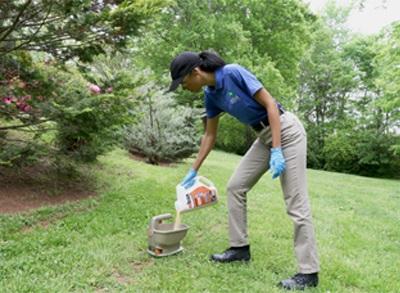
You’re always looking for ways to make your routes more productive and to provide the highest quality pest management services possible. One helpful strategy in achieving that goal is one that is sometimes overlooked in practice as you go through your day-to-day services. By taking advantage of your area’s seasonal weather patterns, you can get ahead of pests before they become a problem for your accounts, enhancing your customer’s experience and your operational efficiency. As the winter snows give way to spring rains, make sure your accounts are ready for the inevitable return of pests by prebaiting.
So, why is spring an ideal time to prebait? Many insect activities are suspended during the winter months. As it gets warmer, insects shrug off their overwintering states to become more active. Ants, for instance, start to grow their colony sizes, resulting in increased foraging. This moment—when insects are just beginning to
emerge, but natural food sources are not yet widely available—is an ideal time to perform a preliminary insect bait treatment around the perimeter of a structure. The bait will be the most attractive food source available to pests during this period, which can increase their efficacy against entire pest populations as the baits are more
likely to be consumed and for foragers to bring it back to nests or harborages.
When prebaiting around the perimeter of a structure in the early spring, it is typically best to select a granular bait. Granular baits are fit for most cases because they have the potential to attract multiple insect species groups, including crickets, roaches, silverfish, some other occasional invaders and, of course, ants. The characteristics of the bait, such as particle size and food-based attractants, help promote its effectiveness against a particular pest insect species. For example, there are some larger granular baits that attract carpenter ants more effectively than others, while some smaller ant species, such as the little black ant, might not find a larger granular size attractive at all. Other insects, such as silverfish and firebrats, tend to forage in a non-specific manner and are less prejudiced about particle size. These groups are general feeders and forage for a large swath of food items.
The active ingredient of the bait will also impact your overall strategy. Some active ingredients work faster than other compounds like borates. However, very fast-acting toxicants can produce a population rebound effect in certain insect species (such as ant species whose colonies have multiple queens), potentially resulting in more frequent callbacks in your accounts. Active ingredients that have a delayed action, such as borates, can be beneficial because the baits are consumed and spread throughout the colony before they take effect, allowing for a wider impact on the pest population.
There are additional benefits to using borates as part of your baiting program. Borates do not result in any known physical resistance in insect populations and can be used in conjunction with other active ingredients. Prebaiting with a borate-based granular bait like Niban® can help you control the populations of a wide variety of pests just as they are emerging after winter and because it is borate-based option, it can remain a vital component of a bait rotation schedule during the rest of the months when pests are active. In fact, Niban will not degrade in sunlight and can withstand up to 6” of water, meaning that it can remain active long after your
application when pest do emerge.
In addition to prebaiting with granular baits, liquid baits are also useful in a baiting program. Some insect pest species prefer liquid baits over granular ones because they find the liquids easier to consume. Argentine ants, for example, are more prone to consuming liquid ant baits than particle baits, particularly in drier climates. Using liquid baits in conjunction with granular baits can help lower initial colony sizes, resulting in an overall reduction of colony numbers. It is also advisable to move the liquid bait stations according to changes in foraging patterns and colony movement to maximize results, being sure to monitor them so they can be refilled or changed as necessary. Additionally, it’s important to remember that baits do not
remain equally attractive at all times. In early spring, using a liquid bait like DominAnt® as a secondary line of defense is a great option. DominAnt can be placed outside around the structure or inside the structure near openings (such as near doors or between windows and their screens) to reinforce the success of your perimeter granular baiting program.
At the end of the day, attention to detail is what maximizes results. Spreading granular baits and placing liquid stations strategically and based upon the pests you are targeting will help efficacy and reduce callbacks. Insect behaviors vary from species to species and even within a species as the weather changes. Your field experience and know-how are key to making products as effective as they can be. Some companies, such as Nisus Corporation, offer training videos that show the application process for their products, as well as other resources for technical advice when you’re faced with a challenging account. When choosing to use any product
from any manufacturer, search their website for valuable training videos and tools such as those available on www.nisuscorp.com and www.nisus.tv.

